Climate-Fueled Fires Burn Maui and Big Island; Lives Lost
UPDATE SEPT 15th, 2023:
The number of people who died in the fire that swept through Lahaina has dropped from 115 to 97, Maui Police Chief John Pelletier said Friday. He also said the number of missing now stands at 31, down from an initial high of over 3,000 people.
PREVIOUSLY PUBLISHED: AUG. 27th
Maui Fire’s Missing-Person List Falls to 388 After FBI Vetting
- List of missing was expected to shrink as duplicates removed
- Death toll still 115 after check of Lahaina’s last buildings
The list of people who remain unaccounted for after Maui’s wildfire disaster dropped to 388, a significant decline from earlier estimates, after hundreds of individuals initially reported missing were found.
Maui County has released a list validated by the Federal Bureau of Investigation of those unaccounted for since the Aug. 8 wildfire tore through the seaside town of Lahaina. An additional 1,732 people who had been reported missing have been found safe and well as of late Thursday afternoon, the county said in a Thursday statement.
Search teams combing through the last unchecked buildings in Lahaina haven’t found the mass casualties many feared, Governor Green said earlier Thursday, offering a rare positive note in the wake of his state’s deadliest natural disaster.
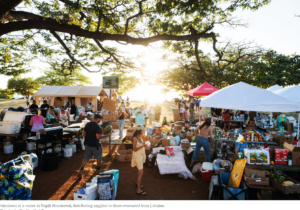 Maui residents cope with loss and come together, as local government response stumbles.
Maui residents cope with loss and come together, as local government response stumbles.
Volunteers at a center in Napili-Honokowai, distributing supplies to those evacuated from Lahaina. Local Maui residents open their homes to Lahaina survivors and extended family members in signs that Hawaii’s Aloha spirit also survived the fire and loss.
Hawaii Gov. Josh Green said progress is being made to get displaced Lahaina residents into temporary housing. “Some individual residents are already in hotels, and larger numbers in the coming days” Green said, adding there were 500 rooms the government was paying for. Rental homes will also serve as temporary homes, the governor added. “Airbnb is going to offer us hundreds of typically short-term rentals in a longer term capacity, so we can put people into a place for months.”
As families face an agonizing wait for word on missing loved ones on Maui, the death toll from the fire is likely to rise. The fire-related death toll on Maui (Lahaina town) has risen to 111 as of Thursday, with more than 1,000 persons still unaccounted and missing. No other details are available. Questions are now emerging about the Maui County government’s and Hawaii emergency early warning response. Absent any official warning, residents and tourists alike were forced to flee for their lives as winds whipped wildfires into a destructive inferno.
In one glaring example, none of the 80 warning sirens placed around Maui were activated by the island or state’s emergency management agencies as the fire bore down on the town of Lahaina, a spokesman for the Hawaii Emergency Management Agency, Adam Weintraub, said on Saturday. He stressed that the sirens alone would not have been a signal to evacuate but to seek more information. Sen. Mazie Hirono (D-Hawaii) said there should be no excuses for warning sirens on Maui not sounding, but indicated that temporary housing and search-and-rescue efforts are a priority over accountability at the moment.
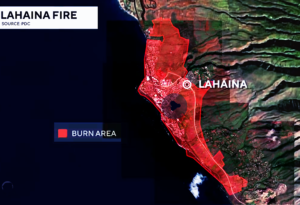
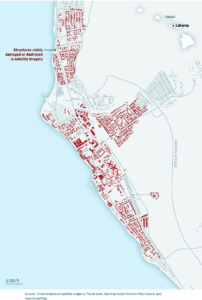
Uncontrolled blazes fueled by drought and high winds tore through the historic town of Lahaina and other parts of the island of Maui this week, killing at least 111 people in what has called the deadliest wildfire in the state’s history.
Hawaii’s islands are covered with lush tropical forests, some of the wettest places on the planet. It once seemed to be an unlikely place to be scorched by fire. But in a warming world, extreme weather disasters can happen anywhere.
The inferno came so quickly that, to escape the smoke and flames, some Lahaina area residents ran into the ocean to escape the fire and where later rescued by the Coast Guard. The most concentrated damage appeared to be in Lahaina, once the royal capital of Hawaii and a major Maui vacation destination, now burned to the ground.
Neighboring Hawaii Island did not escape the same conditions which fueled property losses, but fortunately no lives were reported lost.
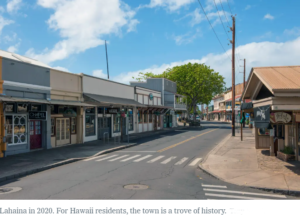 Lahaina, Maui: Before
Lahaina, Maui: Before
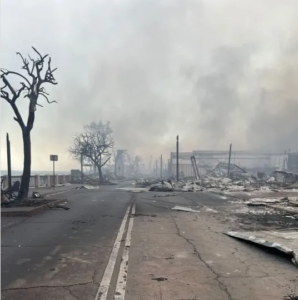 Lahaina, Maui: After
Lahaina, Maui: After
Lahaina Town, a historic and living monument to Hawaii’s Past
For many visitors, the town of Lahaina is a place to go for tropical beaches. But for the residents of Hawaii, it is a trove of the state’s rich cultural history.
The loss of Lahaina’s heritage museum, a landmark that housed artifacts from before the rest of the world knew Hawaii existed, is still being assessed.
Also,was the loss of town’s oldest building, the Baldwin Home, was occupied by the 19th-century physician who saved Maui from an epidemic of smallpox. Its central feature, a sprawling 150-year-old banyan tree, was planted to commemorate the arrival of Christian missionaries in 1873, now lost to fire.
On August 7, more than an hour before Maui authorities said the first fire erupted according to authorities, a security camera at the Maui Bird Conservation Center in the east Maui region of Upcountry, captured a bright flash in the woods. Soon after, parts of Maui burned to the ground and similar fires on Hawaii Island continue to threatened properties and towns on the north end of the island. Events which turned parts of Hawaii’s legacy into ashes are a testament to global weather and climate changes fueling unprecedented global heating and fires around the globe. It is also further proof that even in Hawaii, with its remote Pacific location, they is no escape from the global climate crisis now underway.
Climate-fueled and hurricane-driven wildfires that devastated the island of Maui, razing much of the historic district of Lahaina in only a matter of hours, provides further evidence that future climate-fueled events can strike without warning. “We had no preparation, no warning, nothing,” said Theo Morrison, the executive director of the Lahaina Restoration Foundation, which manages more than a dozen historic sites in the town.
- Hawaii Gov. Josh Green said at a news conference Saturday that the blaze was the result of a never-before-seen confluence of climate-related conditions and warned that it would take a long time for tourism and the community of West Maui to recover.
Big Island, with big climate problems ahead
Rising temperatures, up 2 degrees Fahrenheit in Hawaii since 1950, have contributed to a decades-long trend of reduced rainfall. Reduced precipitation makes vegetation more prone to catching fire. The blazes this week happened in areas with moderate to severe drought.
Slowing global climate change is a must. But that will not be enough. Whatever we do now, in the next couple of decades, you’re going to have more and more dry, hot windy situations. Translation of knowledge to action is something that we have to invest in. Underlying dry conditions were exacerbated by strong winds tied to Hurricane Dora, a Category 4 storm that is moving across the Pacific hundreds of miles to the south. Experts also noted the spread of nonnative grasses, which are more flammable than indigenous plants.
Similar trends have made humid forests across the world more vulnerable in recent years. Small fires, often caused by human activity, can quickly become uncontrollable blazes as once again demonstrated in this latest round fires impacted the island state, but with one important development, lives lost.
“The fire hazards have gone way up,” said Josh Stanbro, the former chief resilience officer for Honolulu. “This is part of a long-term trend that is directly related to climate changes.”
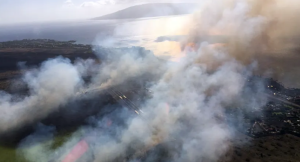 South Kohola, Hawaii Island (Maui in the distance)
South Kohola, Hawaii Island (Maui in the distance)
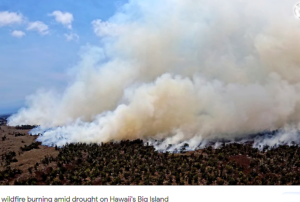 South Kohola, Hawaii Island
South Kohola, Hawaii Island
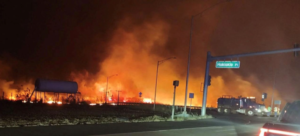
There are currently no uncontrolled wildfires on Hawaii Island being reported. For developing fire information, go to: Hawaii County Civil Defense Notifications to receive timely and essential alerts, and view the most recent Civil Defense Updates on the Hawaii County Website.
The Lahaina Fire, “Flash Drought” driven
The Maui fire was greatly intensified by high winds, caused by the combination of a strong high-pressure system to the north of the island and the powerful Hurricane Dora to the south, i.e., a Flash Drought. Those same atmospheric forces worked together like an eggbeater, whipping winds with gusts of up to 80 miles per hour. Climate change has been predicted to intensify both high-pressure heat domes and tropical cyclones such as Dora.
According to NOAA, a Flash Drought intensifies rapidly due to changes in precipitation, temperature, wind, and solar radiation. These changes in the weather increase evapotranspiration and lower soil moisture. Flash droughts can cause extensive damage to agriculture, economies, and ecosystems if they are not predicted and discovered early.
Climate change, as scientists have long anticipated, is making the weather more extreme and unpredictable.
This summer, we’re being taught the tragic lesson that we all need to prepare for “unlikely” disasters as well as familiar ones, and to look for risk in new places. The deadly wildfires on Maui that gutted Lahaina were a by-produce of climate-fueled weather conditions and the surrounding Maui hillsides covered with nonnative, invasive grasses — originally planted on the island by humans — which burned explosively.
Those grasses surrounding Lahaina were so dry and flammable because the island, especially the area around Lahaina, conditions driven by a so-called “flash drought.” In late May, none of the island was unusually dry, according to the U.S. Drought Monitor. Today, the whole island is either abnormally dry or experiencing moderate to severe drought. Scientists have warned that flash droughts will occur more frequently because of climate change.
July was officially Earth’s hottest month on record.
Even in the Southern Hemisphere, where it’s winter, there have been unusual warming patterns. Scientists are worried about Antarctica’s unprecedented lack of sea ice growth. Parts of Chile and Argentina have also seen temperatures soar in the depths of their winter.
Canada is still fighting blazes through its worst wildfire season ever. By mid-July fires scorched more than 10 million hectares (25 million acres), an area about the size of Iceland, with no end to the burning expected anytime soon.
This is how much extreme heat is costing the US a year, according to President Biden. His Administration this week is seeking an additional $12 billion for disaster assistance, as the administration monitors wildfire devastation in Hawaii and peak hurricane season approaches.

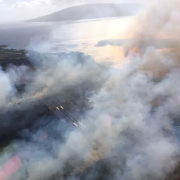


Too many coincidences with the Maui fires…. Everyone in charge out of town, fires all start at the same time, DLNR won’t give water, HELCO won’t turn off the electricity and sparking fires, No Sirens cause they think residents are idiots and would run uphill to the fire, No bullhorns or door to door, Fake news that the fire was out…. Law Enforcement Preventing assistance to residents…